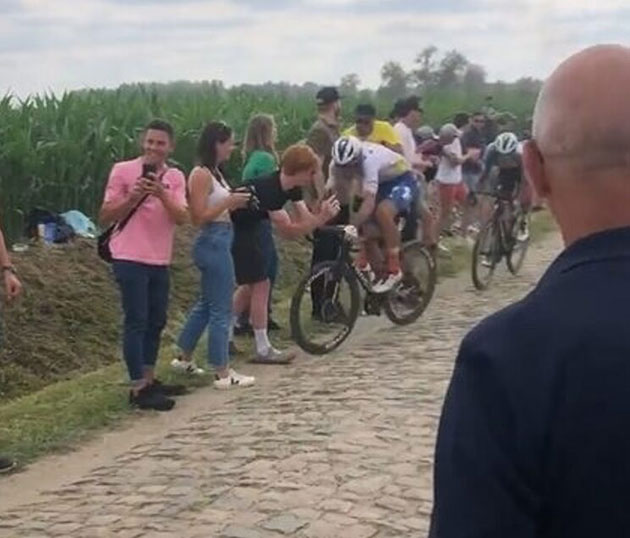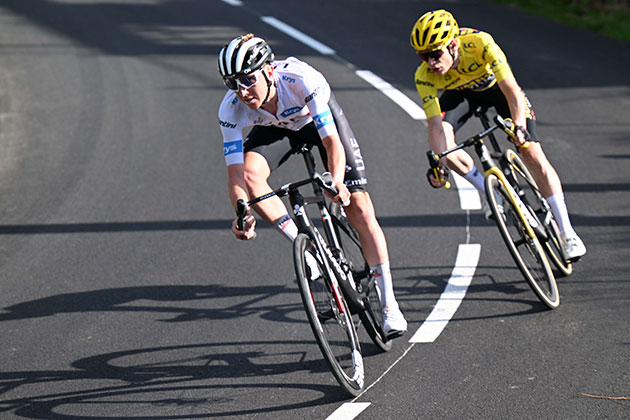

David L. Stanley
2023 Tour de France after week two:
Five items to consider
David Stanley is an experienced cycling writer. His work has appeared in Velo, Velo-news.com, Road, Peloton, and the late, lamented Bicycle Guide (my favorite all-time cycling magazine). Here's his Facebook page. He is also a highly regarded voice artist with many audiobooks to his credit, including McGann Publishing's The Story of the Tour de France and Cycling Heroes.

David L. Stanley

David L. Stanley's masterful telling of his bout with skin cancer Melanoma: It Started with a Freckle is available in print, Kindle eBook and audiobook versions, just click on the Amazon link on the right.
David L. Stanley writes:
Five Items to Consider on 2023 Tour de France Rest Day Number Two
Item Number One. It is long past time for a true white jersey. The current rules provide for a maillot blanc for the highest placed rider on G.C. under age 26. As top cyclists over the past 20 years have been trending younger and younger, the idea that a “young rider” is one under 26 is a retro-notion that needs to go away with 6 speed rear clusters and real chamois in the shorts.
176 men started the race. I don’t know how many riders are under 26 in this year’s Tour. I’m not going to count. It’s a bunch. Darned near a peloton’s worth, I suspect. What the white jersey should measure is who is the best debutante, regardless of age. My modest proposal – Change the white jersey competition and award it to the highest placed true Tour debutante; that rider who is racing in his first Tour de France.
I can tell you, it would be a big competition. I did count the riders in their first Tour. From Frenchman Clément Berthet (AG2R Citroën Team) to his countryman Axel Zingle (Cofidis), there are 36 riders from across the globe in the debut Tour. France and Australia bring 6 each. Norway has 5. Denmark, Belgium, and the Netherlands; 3 each. Great Britain and Spain show 2. With 1 rider each, we find Austria, Eritrea, Spain, Germany, Kazakhstan, and New Zealand. Surely, we can all find one rider in his first Tour de France to root for, regardless of an arbitrarily designated age that no longer has any basis in racing reality. And yes, to answer the unsaid question, you get one shot, and one shot only, at the white jersey. That’s it. That’s what a debut is – that moment when you first show up on the scene.

Tadej Pogacar has won the Tour twice, and here is in 2023 in white. Sirotti photo
Item Number Two. The Social Media Idiots. As I have dubbed them for the Tour - Société des Idiots des Médias Sociaux. One of the great sights of the Tour de France: riders in a tête à tête duel up L’Alpe D’Huez in a narrow corridor of fans, each fan screaming maniacally for their favorite. I don’t want that mania to ever leave the Tour. For many of those years, there was respect for the riders. Not always: balloons of urine or cups of vinegar thrown at riders, tacks on the road, the rare spectator stepping in front of a charging Bugno, Guerini slamming into a fan taking a photo, but those were more rare than commonplace.

19834 Tour de France, stage 16: Joop Zoetemelk and the fans on Alpe d'Huez
In the last twenty years, as social media has exploded, we’ve seen an equal explosion of stupid fans who insert themselves into the race to gain a few moments of Tour de France notoriety. It was a fan who held a sign shouting “Allez opi-omi!” that crashed out Sutterlin immediately, and damaged Tony Martin’s hopes and health. It was the idiots who leaned into the parcours last summer to shoot a little video, crashed out Daniel Oss and broke his neck. That same crash totaled Australian cyclist Michael Gogl. He broke his collarbone and pelvis/iliac crest and had to be treated for arterial damage.

Daniel Oss about to crash.
In the earlier days of fandemonium, it was fervor for the men and the race that led people to act like complete morons at the roadside. Today, it’s about getting a bunch of likes and shares on BlueSky, Discord, Facebook, Instagram, Mastodon, Pinterest, Post-news, QQ, Reddit, Snapchat, Spoutible, Threads, TikTok, Twitter, YouTube … I feel like I’m leaving one or two out of my list. Those little spurts of dopamine when someone likes your post are terribly addictive. I know. I love social media. But I love respect for the race and healthy bike racers a lot more.
Again, a modest proposal. Constant education and peer pressure. The publicity caravan needs to be stocked with cool pamphlets about how to behave at the race. People need to inundated with TV coverage that stresses the idea that riders need their space. People need to learn how to speak to the race-invader who stands in the middle of the road with his iPhone so that a) he leaves the road, and b) doesn’t punch anyone on his way off the piste.
There is an old saying that if you want your kid to grow up well, the trick is to get them in a good group of kids and let positive peer pressure take its course. This isn’t a lot different. Failing decency, and trust me, I realize that’s likely in the 2020s, the moto-guard needs to be given the right to issue costly tickets and court appearances for what is, in essence, invading the pitch. The situation at the roadside is bad, and will get worse.
After witnessing Sunday’s massive fan-caused pile-up that dumped perhaps 50-60 riders from their machines, I have another modest proposal: A special moto-squad, equipped with cattle prods. That’ll get their attention.
Item Number Three. Fans with road flares. They need to banned immediately. Have you ever been near the home fan base at a football/soccer match when those self-serving asshats start to pull off the tabs of the flares? It instantly fills the air with a hot, chalky dust that makes breathing impossible. It’s impossible even if you are merely standing there trying to cheer for Watford or my local side, the Flint City Bucks. So, yeah, these guys have been racing across the valley floor at 55 kph for the last 40 km and now are on a 14 km climb that averages 7% with sections of 12% and let’s make it damn near impossible to breathe.
How to solve the issue? Again, education is the first step. I do believe that most fans, even the most rabid, are generally reasonable when properly approached. If a ban and peer pressure and police presence doesn’t work, I have, yet again, another modest proposal. Equip the modern racing bicycle with a handlebar mounted taser.
I hate road flares at sporting events. They belong in the emergency kit of your vehicle, not blowing smoke into the faces of highly tuned professional athletes.
Item Number Four. Are these riders clean? A reasonable question – Kuss, Pidcock, and Pogačar, among others, have all set somewhat ludicrous Strava KOMs this Tour. Ludicrous? Sure, especially when you consider that they’ve already raced over 2,000 km and spent hours, day after day, in their red zones. We’ve seen this movie before. Vingo and Taddy set a record ascent of the Tourmalet on stage 5, the fastest since Rominger and Jaskula’s jet-fuel powered fly-by 25 years ago. On Saturday’s ascent of the Joux Plane, they certainly would have broken Pantani’s 1997 record of 32:56 had they not slowed and started boxing for position to take the time bonuses.

Tadej Pogacar & Jonas Vngegaard descend the Joux Plane. Sirotti photo
Let me give you some context. I started to pay attention to bike racing in the early 1970s during the first US granola-crunching-bike boom and in the midst of the first serious round of doping. Amphetamines to get you launched, tranquilizers so you’s could sleep, and cortisone to try and allay the damage your doping did. You do remember the famous Jacques Anquetil quote? “One must not speak of doping, but of ‘treatments’ and ‘treating yourself.’” He also said, “You cannot race the Tour on mineral water.”
As doping tests improved, we left those less effective PEDs behind and moved onto blood doping. Too many top athletes and teams to count were blood-doping and steroidizing at the 1984 Games in both summer and winter. This gave rise to one of the greatest derisory nicknames in sports history. The great Finnish Nordic skier Marja-Liisa Hämäläinen was dubbed Marja-Liisa Hemoglobin in the sporting press.
Of course, we all recall the Dark Times. It was simply impossible to be competitive in much of the 1990s and 2000s unless one used EPO, and often, testosterone. We also remember all those athletes who died mysteriously in their sleep at the outset of the EPO era due to cardiac issues that presumably were linked to sky-high red blood cell counts.
Ergo, as we see these riders setting fresh times on the climbs not seen since the Dark Times, it is fair to question the legitimacy of these speeds. In fact, it’s imperative to question these speeds. I believe, cautiously, that today’s rider are clean. Here’s why, in alphabetical order:
1) Aerodynamics: From pedals & shoes to helmets & jerseys and everything in between, the silhouettes presented to the wind are thinner, narrower, and far less wasteful. Jerseys are painted on. Shoes and pedals are far more aero (and that’s an area that was ignored until recently). Helmets are far more aero than in the early days of the Bell Bowl and the first iterations of the Giro. Framesets are far more aero. Wheels are designed as units. The tire/rim junction is addressed. Deeper section wheels are faster than ever and still manageable in crosswinds. They are also stiffer and feature much less energy loss.
2) Biomechanics: High-performance carbon fiber shoe soles and orthotics. This can’t be over-emphasized. Modern riders are fitted properly, from the shoe sole up to the saddle and bars. Ankles and knees that used to wobble in and out with every pedal rev (100 times a minute x 60 minutes per hour x 5 hours) now are rock solid power transmission devices thanks to orthotics and modern shoes.
3) Drive train: Carbon fiber cranks, ceramic bearings, oversize pulleys, ultra-low friction chain treatments. I loved the Campy Record gruppo on my Colnago Superissimo. It was lustrous and polished like a fine gem. But the performance of that gruppo, when compared to a modern Grand Tour race bike, is like a comparison between the McLaren of Alain Prost to the RedBull-Honda that Max Verstappen drove to victory in the Spanish GP earlier this month. The Eroica movement is lovely. I celebrate it at every opportunity. Nobody’s winning a stage of any modern bike race on a 1984 Gitane as ridden by Laurent Fignon.
4) Skeletal riders: Light is right. And mo’ lighter, mo’ bettah. Cyclists have always been lean. But the 7% body fat sported by Bernard Hinault looks downright hale and healthy compared to the 3-4% levels we see today. Modern dietary science has given modern athletes the tools to train hard, eat adequately, and get lean. There’s also the distinct possibility that the athletes are using Mounjaro as a leanness aid. The winning rider in this third decade of the 21st century is skin stretched over fascia with nothing in between. It’s not healthy. It’s not attractive. It is a requirement to be competitive at the highest levels.

The very lean Lotto Dstny team before stage 10. Sirotti photo
5) Training and recovery: “ride lots.” We’ve all heard it and it worked pretty well for many years. It doesn’t work anymore. Targeted training, power meters, altitude tents, dietary recovery aids, it’s a long list, and I’ve gone on nearly long enough. The riders have a coach. They have a physiology specialist. They have sport scientists. They have personalized evidence-based nutrition. Their recovery is aided by devices like the Normatec boots. The science is overwhelming. So are the results. In Eddy’s day, riders were warned not to eat too soon after a hard training day, and then only a bit of clear soup because digesting food too soon is too hard on the body. And bread is bad for riders. And. And. And. Yeah, in 2023, we don’t play that.
6) Tire technology: Wider tires, lowered rolling resistance, less hysteresis, aero rims and spokes, improved cornering characteristics. The less energy wasted at the critical tire-road interface, the faster the rider. As much as I loved my Vittoria CX/CG combo in 1984, a modern tubeless tire is several time zones ahead of that fine Italian rubber.
Item Number Five. The Team. Every coach preaches it. Winning teams believe it. Winning TV shows like Ted Lasso have incorporated it into a moving message of teamwork and brotherhood. Yet, plenty of cycling fans still don’t quite understand how this works. I’m not going to explain it to you. Just watch the last 25 km of every stage. When it is a sprint stage, the teams with the master-sprinters mass at the front to discourage attacks, and provide an air-cushion of comfort for their ace sprinter. You know that, right? Good.
Now, watch the last alpine climb on every true climbing stage with the GC on the line. Taddy and Jonas always have at least two, and usually three henchmen with them to set the pace and give them the same air-cushion that the sprinters receive. Old-school wisdom used to believe that aerodynamics at climbing speeds were not altogether that important. The team riders were there to chase down attacks. In the modern game, where riders are climbing 8% grades at speeds few recreational cyclists can match on the flats, the GC contenders need the shelter of a teammate to save their energy for their last attack.
It’s all about the team. It’s all about “BELIEVE.” In this race, where 2,607 km have been raced and only 10 seconds separates Taddy and JV, it will be the team that best helps their leader preserve his energy that will riding the lap of honor on the Avenue des Champs-Élysées next Sunday.

Wout Poels wins stage 15. Sirotti photo
By the way, if you didn’t root for 35 year old Wout Poels (Bahrain Victorious) on Sunday and 22 year old Carlos Rodriguez (Ineos-Grenadiers) on Saturday, well, you do sport all wrong. Check yourself.
Vive la France! Vive la Tour!
David Stanley, like nearly all of us, has spent his life working and playing outdoors. He got a case of Melanoma as a result. Here's his telling of his beating that disease. And when you go out, please put on sunscreen.







